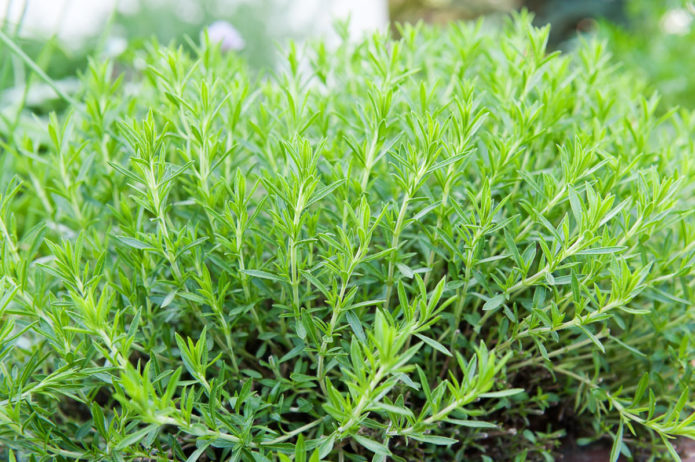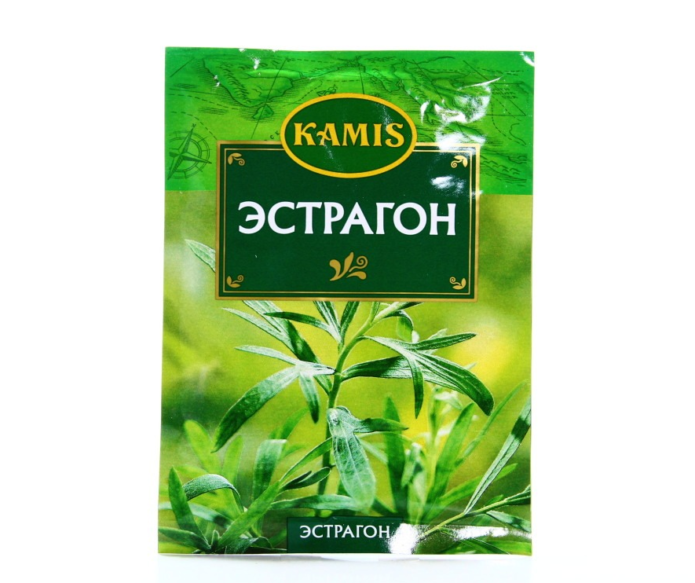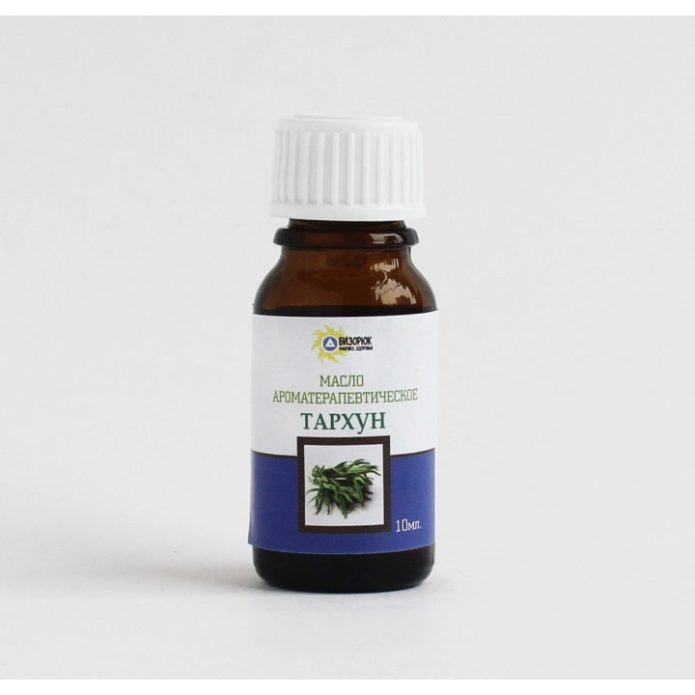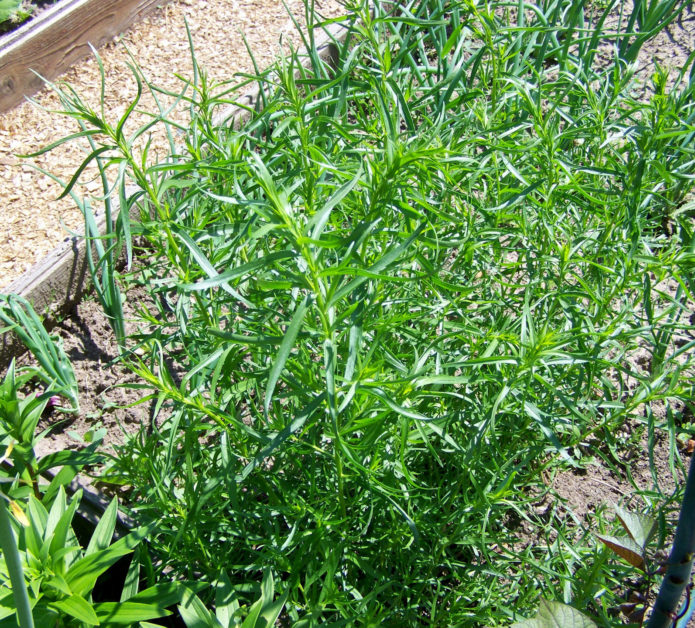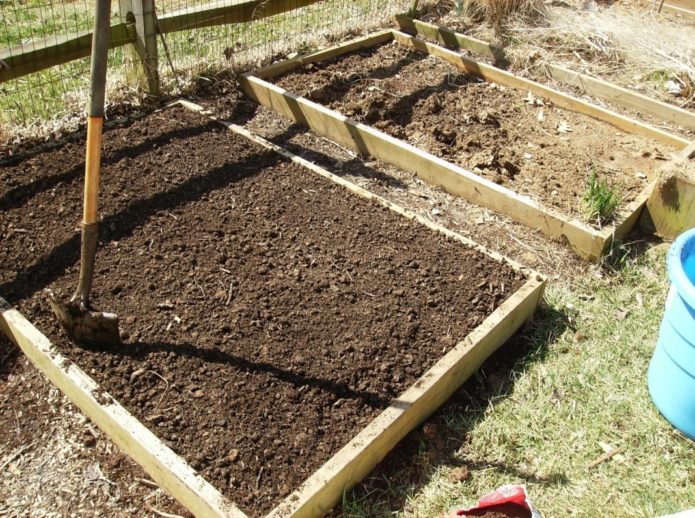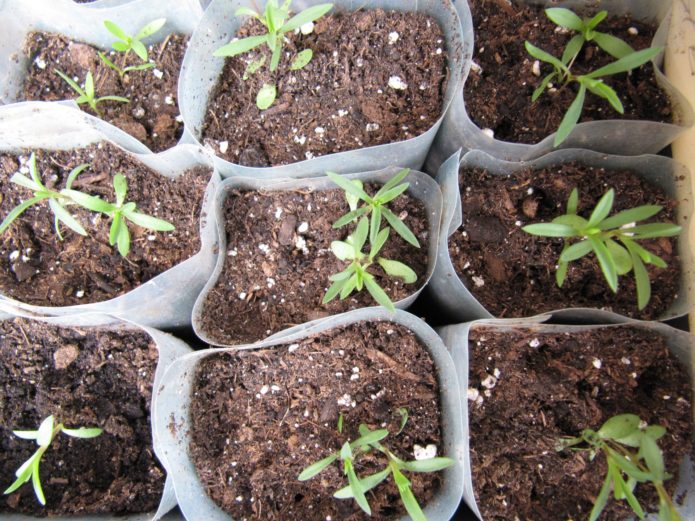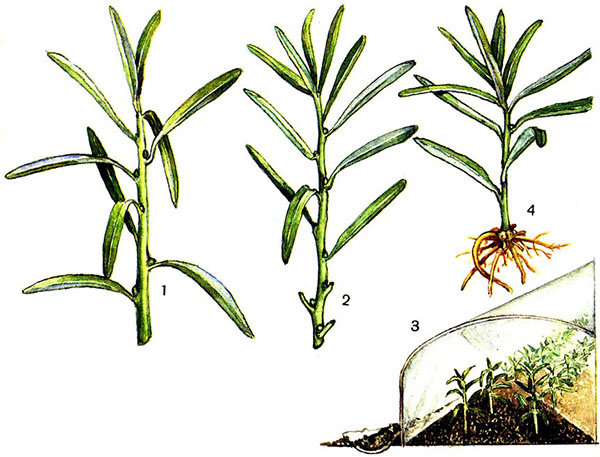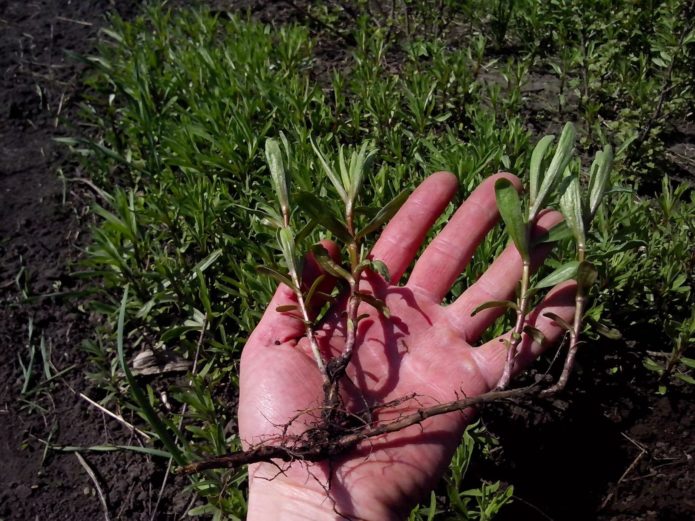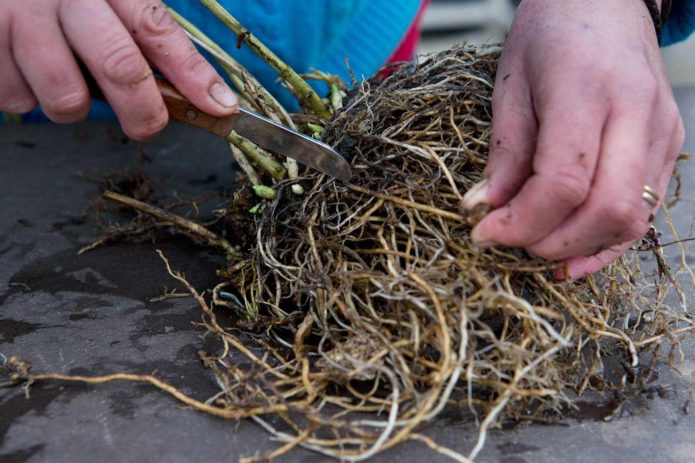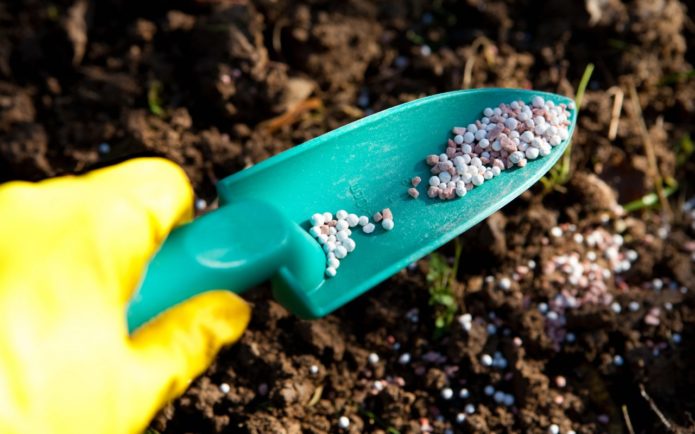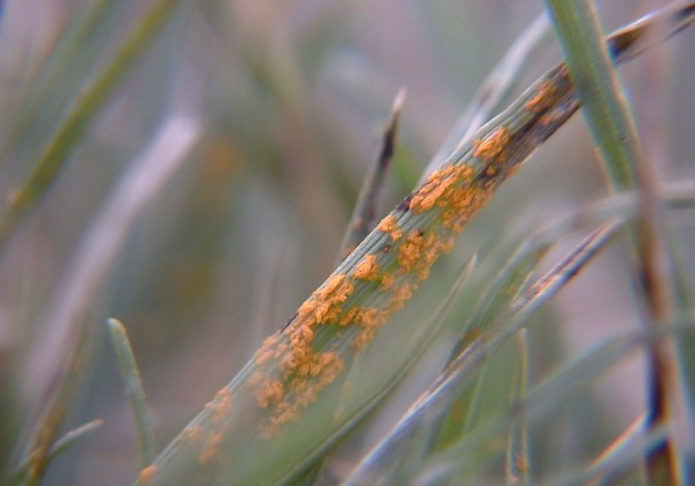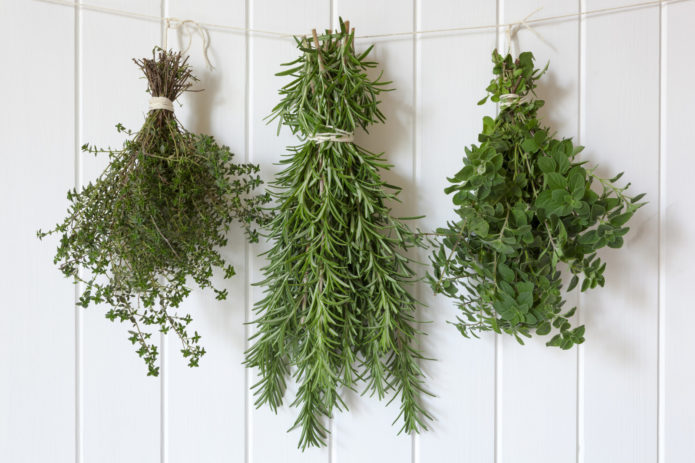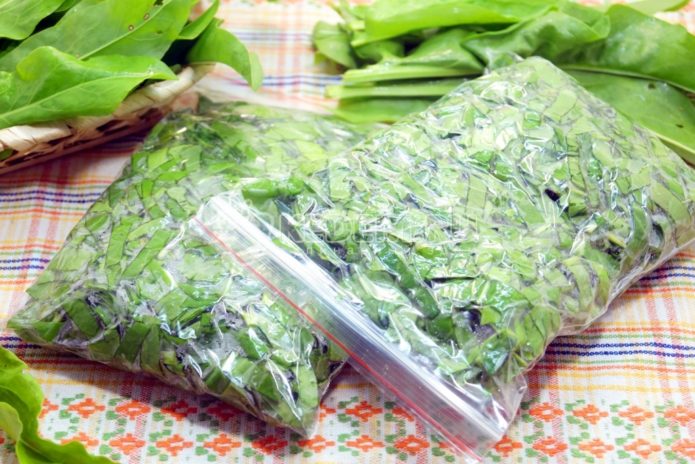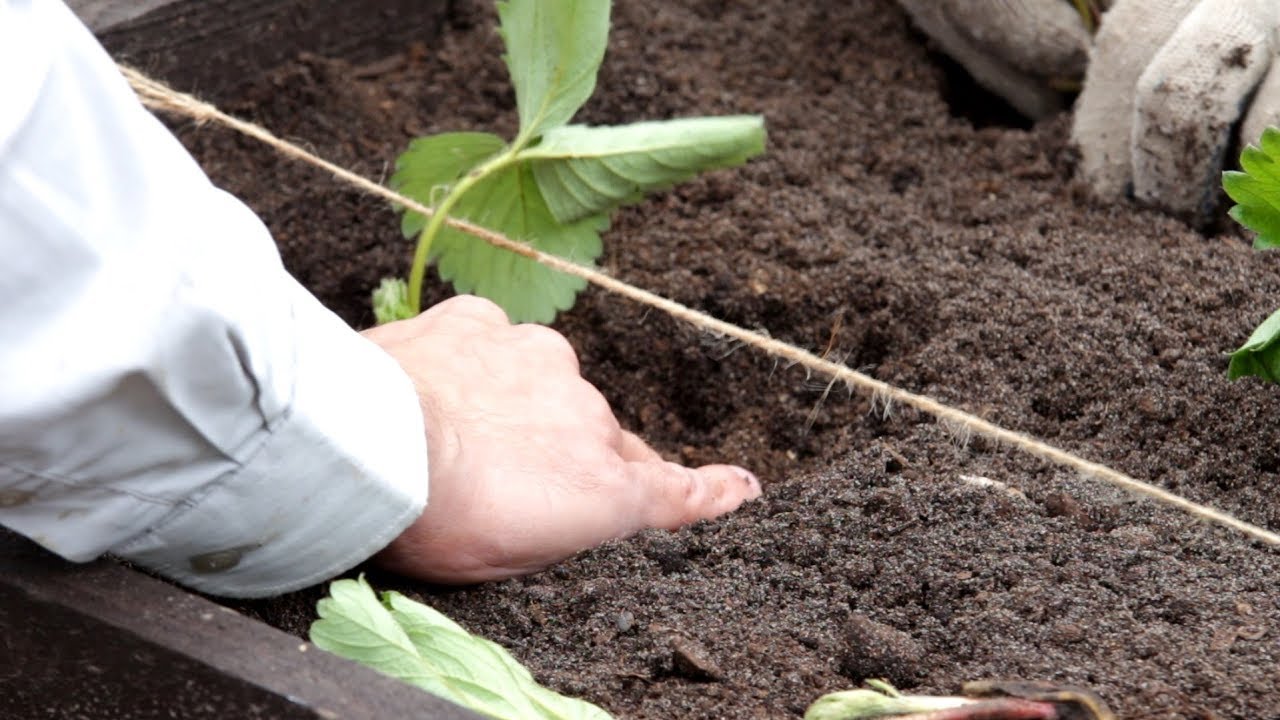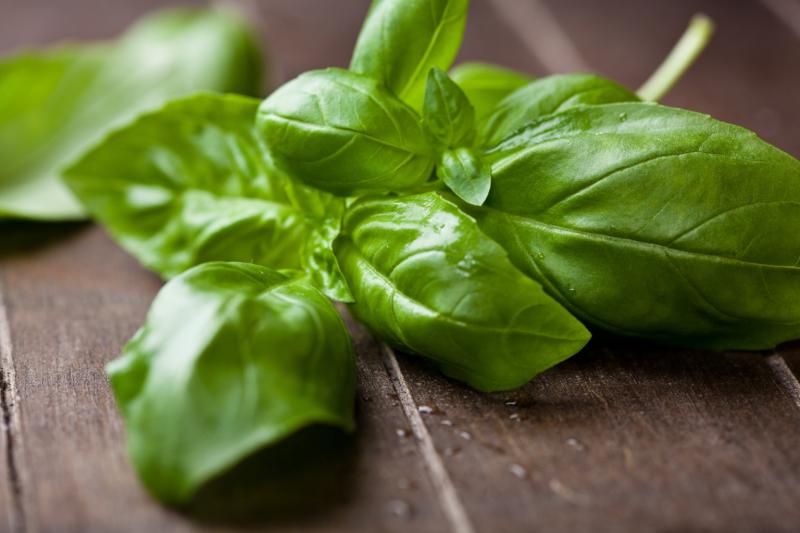Tarragon, better known as tarragon, scientifically known as tarragon wormwood (Artemísia dracúnculus), is a spicy herbaceous perennial, which is the closest relative of common wormwood and belongs to the Asteraceae family (Asteraceae). In the wild, it grows in northern America (from Mexico to Canada), in eastern Europe, in Central and Southeast Asia. On the territory of our country, it can be found in the Far East, in the west and south of Eastern Siberia, as well as in European regions. The plant prefers to inhabit open areas on stony dry slopes, pebbles, and occasionally in cultivated fields as a weed.
Content
Cultivated varieties of tarragon
Tarragon is a short bush from 0.4 to 1.2 m, with few straight, strong stems of yellowish-brown color. Dark green or glaucous petiolate leaves 3-4 cm long and no more than 0.4-0.7 cm wide have an elongated lanceolate shape with pointed tips. Small greenish or light yellow flowers, collected in paniculate or basket-like inflorescences, open in early summer. In their place, towards the end of October, small oblong achenes ripen, filled with very small dark brownish-brown seeds. The rhizome is intricately convoluted, thick and woody. The plant winters well in the ground, even in winters with little snow it easily survives severe frosts.
The ground green part of tarragon contains a lot of nutrients, vitamins and minerals:
- flavonoids;
- alkaloids;
- resins, essential oils;
- carotene;
- coumarins;
- vitamins (C, A, PP, group B);
- trace elements (Ca, Na, Fe, K, Mg, P, I).
The rich chemical composition determines the beneficial properties of this plant, which make it possible to successfully use it in folk medicine. Tarhun acts as follows:
- strengthens the skeletal system;
- enhances sexual function;
- enhances immunity;
- relieves anxiety and excessive stress;
- normalizes kidney function;
- reduces pressure;
- has an anthelmintic effect;
- helps with colds and flu;
- stimulates appetite and improves digestion;
- regulates the menstrual cycle.
In addition to medicinal properties, tarragon has excellent taste and has long been used in cooking.... Its spicy, refreshing and slightly pungent taste with hints of mint and anise is appropriate as an original seasoning for first and second courses (meat and fish), in salads, sauces and soups, for canning fruits, various berries, vegetables and mushrooms, as well as for making some alcoholic beverages. The aromatic essential oil is actively used in cosmetology and aromatherapy.
Tarragon came to Europe in the 17th century. The French were the first to use this spice in food.
In culture, two varieties of tarragon are grown:
- French. A bushy plant with thin stems and small narrow leaves, which has a delicate, refined aroma with bitterness. It is widely used by cooks in fresh and dried form.
- Russian. Taller grass with larger leaves and branches. It smells spicy and tender, but rather faint, barely perceptible. Fresh is often used in food.
Growing tarragon in the open field
For tarragon, a separate bed or area in a well-lit, sunny place should be set aside... The culture develops best of all on loose, moderately fertile and drained soils with a level of acidity close to neutral (pH 6.5–7). Does not tolerate swampiness and excess moisture at all, the rhizome can rot. In one place, the tarragon bush grows up to 15 years, but every year its greens coarse and lose their aroma. Therefore, it is recommended to rejuvenate the herb after 4–5 years.
How to plant tarragon
The site where it is planned to plant tarragon must be prepared in advance.... Even in the fall, the earth needs to be dug to a depth of at least 25-30 cm, while choosing the roots of perennial weeds, and at the same time to add 1 m2:
- well-rotted manure or humus - 5–6 kg;
- superphosphate - 50–55 g;
- potassium chloride - 25-30 g
Acidic soils must be alkalized with dolomite flour, fluff lime or chalk (25–30 g per 1 m2). In the future, 100 g of wood ash is poured under each plant annually. Sand (9–10 kg), rotted sawdust (5–6 kg) or peat (5–6 kg) are added to heavy clay soils.
In the spring, during the planting of tarragon, 10–15 g of nitrogenous fertilizers (urea, ammonium nitrate, etc.) are poured directly into each hole.
Planting material is obtained in several ways:
- from seeds;
- cuttings;
- root suckers;
- rhizome.
Seed method
Sowing in open ground can be done in early spring, as soon as the snow cover melts, or in the fall before winter, since the culture is distinguished by enviable cold resistance.
The technology is as follows:
- The seeds are pre-soaked for 10-12 hours in a solution of any biological stimulant of root formation (Epin, Heteroauxin, etc.). They use only grains that have fallen to the bottom, floating empty specimens for sowing are not suitable and are thrown away.
- Then the seed is dried and mixed with sand to ensure the uniformity of seedlings, because tarragon seeds are very small.
- On the prepared bed, parallel shallow grooves (1.5-2 cm) are made at a distance of 0.6-0.7 m between themselves and they are well moistened.
- Sow the seeds as evenly as possible. From above, you do not need to fall asleep with earth, as this greatly reduces germination.
- The first shoots appear after 15–20 days. The optimum temperature for their development is considered to be around + 18 ... + 20 ° C.
- When two pairs of true leaves are formed, the seedlings are thinned out, leaving 10-15 cm between them.
Most often, tarragon is grown through seedlings, sowing is carried out in March:
- The prepared seed material is evenly spread on the surface of the moistened soil with which the planting container is filled.
- The container is covered with transparent glass or plastic wrap to create a mini-greenhouse.
- Put it on a not very hot windowsill (you can go to a greenhouse).
- The shelter is removed from time to time for ventilation, condensation is removed.
- At first, before the emergence of seedlings, the temperature is maintained at + 22 ... + 24 ° C, then it is lowered to + 17 ... + 19 ° C.
- When the shoots appear (after 2-3 weeks), the shelter is removed.
- Thickened seedlings are thinned out. Seedlings dive after the release of 2-3 true leaves.
- In open ground, tarragon seedlings are planted at the very end of spring or early summer, leaving at least 30-60 cm between individual plants.
Tarhun has an extremely negative attitude to waterlogging, so you need to water the seedlings very carefully and moderately.
Video: sow tarragon
Cuttings
Planting material is cut in late May, early June or August... The bottom cut is usually made oblique so as not to confuse. It should be 3-4 cm below the last pair of leaves. The length of the cuttings is about 10-15 cm.
The further sequence of actions is as follows:
- Tarragon cuttings with a beveled lower end are dipped for 24 hours in a solution that stimulates the growth of the root system.
- They are planted, deepening 3-5 cm, in a mixture of garden soil, humus and sand, taken in equal parts.
- Cover with foil to create a greenhouse effect.
- Ventilate regularly, keep the soil slightly moist.
- After a month, when the root system of the seedlings is well formed, they are transplanted to the right place.
At first, young tarragon seedlings need to be shaded.
Root offspring
The creeping rhizome of tarragon produces a large number of root suckers. The shoots are separated from the mother plant, it is better to do this at the beginning of summer, so that the plants have time to grow, then they are planted at the selected site. At the same time, the root collar is placed 5–6 cm below the soil level, the ground part is cut to 15–20 cm. The seedlings are watered abundantly.
For amateur breeding, this method is most suitable, since it does not present any difficulty.
Dividing the bush
A plant that has reached 4–5 years of age is dug up in early spring or late summer. The earth is shaken off from the bush, then the curved and diseased parts of the root are cut off. The rhizome is carefully divided with a sharp tool (knife, pruner, etc.) or simply by hand into the required number of parts, each of which should have 2-3 buds, strong and healthy. Then the cuttings are planted in a prepared place.
For better rooting, it is recommended to hold the rhizomes of the separated plants in the growth stimulant solution (2-3 hours).
How to care for tarragon outdoors
Tarragon grass does not require special careful care, because it is completely unpretentious.
Agrotechnics consists of the following activities:
- Watering. A spicy culture does not like excessive moisture, therefore, even in a hot period, tarragon is watered more often than once every 10-15 days... But watering should be plentiful so that the soil is saturated to a depth of 40 cm. If the weather is wet and rainy, then the grass will have enough precipitation. After irrigation, the land under the bushes must be loosened.
- Weeding. Weeds are removed only in the first season after planting, when the plants are still small. In the future, tarragon itself displaces all other cultures growing in the neighborhood. It is even recommended to limit the spread of creeping rhizomes by digging slate fences, pieces of iron, etc. into the ground. Even an old bucket or a tank without a bottom will do.
- Top dressing. In the spring, before flowering, plants are fertilized with a mixture of superphosphate (25-30 g), potassium salt (10-15 g), ammonium nitrate (15-20 g) per 1 m2... The granules are evenly distributed under the bushes and shallowly embedded in the soil with a rake.After each cut, organic matter is used (for 1 bush 3-4 l):
- infusion of mullein (1: 8);
- infusion of bird droppings (1:15);
- herbal infusion (1: 8);
- wood ash (100-150 g), you can dilute it in water.
Too much nitrogen-containing fertilizers should not be applied, since tarragon is prone to accumulation of nitrates in the ground part, which will grow extremely actively and violently, but at the same time it will lose its spicy aroma.
Video: growing tarragon
Diseases and pests
Tarragon has some insecticidal properties due to its high content of alkaloids and essential oils, scaring away pests, therefore it is rarely affected by them. But occasionally the tarragon can be attacked:
- Aphid. Plants are sprayed with insecticidal herbal infusions (tansy, yarrow, calendula, onion husks, etc.), powdered with tobacco dust or ash.
- Penny cicada. The bushes are pollinated with fluff lime, weeded in time.
- Wireworm. Timely deep loosening and liming of the earth, as well as planting siderates (white mustard) nearby, will help.
It is highly discouraged to use chemicals to combat harmful insects. In extreme cases, bioinsecticides are used (Verticillin, Bitoxibacillin, Nembakt, etc.), which are used to treat not only the plants themselves, but also the soil under them.
Tarragon is extremely rare because it has an excellent immune system.. The only exception is leaf rust, in which numerous pinkish-brown pads (pustules) appear on the front side of the leaf blade, and the back side is completely covered with an orange-red fleecy coating. Damaged leaves gradually dry out and fall off. Excessive thickening of plantings and an excess of nitrogen-containing dressings can provoke an outbreak of the disease. All contaminated parts must be torn off and burned immediately.
For treatment, use a solution prepared from vegetable oil, baking soda and any liquid dishwashing detergent water (15 ml each), water (4 l) and aspirin (1 table). Spray once a week. In advanced cases, the use of biological products (Fitosporin, etc.) is allowed.
Tarragon: collection and storage
Tarragon greens are harvested 2-3 times during the growing season, starting in April and ending in September. The stems are cut, leaving 10-15 cm from the ground level... Cutting is best done in the morning or evening, always in dry weather.
The highest content of essential oils in the ground green part of tarragon wormwood is observed during the period of budding and fruiting.
You can harvest and store tarragon in the following ways:
- Drying. Cut stems are dried in a draft, in the shade (without direct sunlight), the temperature should not exceed +35 ° C. For storage they are laid out in a tightly closed ceramic or glass container, as well as fabric bags or paper bags... Keep in the dark and cool.
- Salting. The collected tarragon greens are washed well, dried, then chopped finely, sprinkled with coarse salt in a ratio of 5: 1 and tightly placed in sterilized glass jars. Put in the refrigerator (cellar), tightly closed with lids.
- Freezing. The dried green mass (young shoots and leaves) is packaged in small individual bags or plastic containers and placed in the freezer.
- Storage in oil. Prepared and chopped greens are strongly salted, mixed and laid out in glass jars, then poured with any vegetable oil (olive, sunflower, etc.).Store cool under a tightly screwed lid.
Young tarragon in the first year of life is not used for food, since it does not yet have a pronounced aroma. In addition, it is necessary to give the young growth the opportunity to increase the ground mass.
Video: all about tarragon grass
It is not at all difficult to grow tarragon on the site with your own hands. Observing some simple rules and some useful recommendations, you will be able to get fragrant spicy herbs for yourself and your loved ones.
